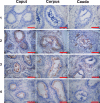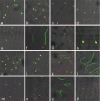Systematic mapping and functional analysis of a family of human epididymal secretory sperm-located proteins
- PMID: 20736409
- PMCID: PMC2984238
- DOI: 10.1074/mcp.M110.001719
Systematic mapping and functional analysis of a family of human epididymal secretory sperm-located proteins
Abstract
The mammalian spermatozoon has many cellular compartments, such as head and tail, permitting it to interact with the female reproductive tract and fertilize the egg. It acquires this fertilizing potential during transit through the epididymis, which secretes proteins that coat different sperm domains. Optimal levels of these proteins provide the spermatozoon with its ability to move to, bind to, fuse with, and penetrate the egg; otherwise male infertility results. As few human epididymal proteins have been characterized, this work was performed to generate a database of human epididymal sperm-located proteins involved in maturation. Two-dimensional gel electrophoresis of epididymal tissue and luminal fluid proteins, followed by identification using MALDI-TOF/MS or MALDI-TOF/TOF, revealed over a thousand spots in gels comprising 745 abundant nonstructural proteins, 408 in luminal fluids, of which 207 were present on spermatozoa. Antibodies raised to 619 recombinant or synthetic peptides, used in Western blots, histological sections, and washed sperm preparations to confirm antibody quality and protein expression, indicated their regional location in the epididymal epithelium and highly specific locations on washed functional spermatozoa. Sperm function tests suggested the role of some proteins in motility and protection against oxidative attack. A large database of these proteins, characterized by size, pI, chromosomal location, and function, was given a unified terminology reflecting their sperm domain location. These novel, secreted human epididymal proteins are potential targets for a posttesticular contraceptive acting to provide rapid, reversible, functional sterility in men and they are also biomarkers that could be used in noninvasive assessments of male fertility.
Figures





Similar articles
-
Proteome profiling of the sperm maturation milieu in the rhesus monkey (Macaca mulatta) epididymis.Reprod Fertil Dev. 2016 Apr;28(6):732-41. doi: 10.1071/RD14322. Reprod Fertil Dev. 2016. PMID: 25354248
-
Mapping of the human testicular proteome and its relationship with that of the epididymis and spermatozoa.Mol Cell Proteomics. 2011 Mar;10(3):M110.004630. doi: 10.1074/mcp.M110.004630. Epub 2010 Dec 22. Mol Cell Proteomics. 2011. PMID: 21178120 Free PMC article.
-
Characterization of secretory proteins from cultured cauda epididymal cells that significantly sustain bovine sperm motility in vitro.Mol Reprod Dev. 2002 Dec;63(4):500-9. doi: 10.1002/mrd.10192. Mol Reprod Dev. 2002. PMID: 12412053
-
Role of exosomes in sperm maturation during the transit along the male reproductive tract.Blood Cells Mol Dis. 2005 Jul-Aug;35(1):1-10. doi: 10.1016/j.bcmd.2005.03.005. Blood Cells Mol Dis. 2005. PMID: 15893944 Review.
-
Contribution of epididymal secretory proteins for spermatozoa maturation.Microsc Res Tech. 2003 May 1;61(1):7-17. doi: 10.1002/jemt.10312. Microsc Res Tech. 2003. PMID: 12672118 Review.
Cited by
-
Comparative analysis of human reproductive proteomes identifies candidate proteins of sperm maturation.Mol Biol Rep. 2012 Dec;39(12):10257-63. doi: 10.1007/s11033-012-1902-7. Epub 2012 Oct 9. Mol Biol Rep. 2012. PMID: 23053934
-
The triple role of glutathione S-transferases in mammalian male fertility.Cell Mol Life Sci. 2020 Jun;77(12):2331-2342. doi: 10.1007/s00018-019-03405-w. Epub 2019 Dec 5. Cell Mol Life Sci. 2020. PMID: 31807814 Free PMC article. Review.
-
Bringing proteomics to bear on male fertility: key lessons.Expert Rev Proteomics. 2024 Apr;21(4):181-203. doi: 10.1080/14789450.2024.2327553. Epub 2024 Apr 10. Expert Rev Proteomics. 2024. PMID: 38536015 Free PMC article. Review.
-
Why are epididymal tumours so rare?Asian J Androl. 2012 May;14(3):465-75. doi: 10.1038/aja.2012.20. Epub 2012 Apr 23. Asian J Androl. 2012. PMID: 22522502 Free PMC article. Review.
-
Distinctive amino acid composition profiles in salivary proteins of the tick Ixodes scapularis.Ticks Tick Borne Dis. 2011 Dec;2(4):219-24. doi: 10.1016/j.ttbdis.2011.09.004. Epub 2011 Oct 18. Ticks Tick Borne Dis. 2011. PMID: 22108016 Free PMC article.
References
-
- Yanagimachi R.Mammalian fertilization (1994). In The Physiology of Reproduction. 2nd Ed.Knobil E., Neill J. D., (eds.) Raven, New York, p. 189
-
- Cooper T. G., Yeung C. H. (2006). Sperm maturation in the human epididymis. In The Sperm Cell: Production, Maturation, Fertilization, Regeneration. De Jonge C, Barratt C. L. R. (eds.) CUP, Cambridge, UK, pp. 72
-
- Suarez S. S., Pacey A. A. (2006) Sperm transport in the female reproductive tract. Hum Reprod Update 12, 23–37 - PubMed
-
- Gu Y., Liang X., Wu W., Liu M., Song S., Cheng L., Bo L., Xiong C., Wang X., Liu X., Peng L., Yao K. (2009) Multicenter contraceptive efficacy trial of injectable testosterone undecanoate in Chinese men. J. Clin. Endocrinol. Metab. 94, 1910–1915 - PubMed
-
- Turner T. T. (1995) On the epididymis and its role in the development of the fertile ejaculate. J. Androl. 16, 292–298 - PubMed
Publication types
MeSH terms
Substances
LinkOut - more resources
Full Text Sources
Other Literature Sources
Molecular Biology Databases
Research Materials
Miscellaneous

